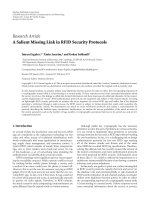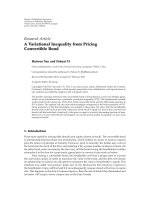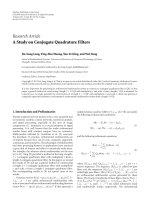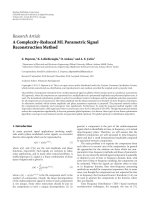Báo cáo hóa học: " Research Article A Hilbert’s Inequality with a Best Constant Factor" doc
Bạn đang xem bản rút gọn của tài liệu. Xem và tải ngay bản đầy đủ của tài liệu tại đây (476.23 KB, 8 trang )
Hindawi Publishing Corporation
Journal of Inequalities and Applications
Volume 2009, Article ID 820176, 8 pages
doi:10.1155/2009/820176
Research Article
A Hilbert’s Inequality with a Best Constant Factor
Zheng Zeng
1
and Zi-tian Xie
2
1
Department of Mathematics, Shaoguan University, Shaoguan, Guangdong 512005, China
2
Department of Mathematics, Zhaoqing University, Zhaoqing, Guangdong 526061, China
Correspondence should be addressed to Zi-tian Xie,
Received 6 February 2009; Revised 3 May 2009; Accepted 23 July 2009
Recommended by Yong Zhou
We give a new Hilbert’s inequality with a best constant factor and some parameters.
Copyright q 2009 Z. Zeng and Z t. Xie. This is an open access article distributed under the
Creative Commons Attribution License, which permits unrestricted use, distribution, and
reproduction in any medium, provided the original work is properly cited.
1. Introduction
If p>1, 1/p 1/q 1, a
n
,b
n
> 0 such that ∞ >
∞
n1
a
p
n
> 0and∞ >
∞
n1
b
q
n
> 0, then the
well-known Hardy-Hilbert’s inequality and its equivalent form are given by
∞
n1
∞
m1
a
m
b
n
m n
<
π
sin
π/p
∞
n1
a
p
n
1/p
∞
n1
b
q
n
1/q
,
1.1
∞
n1
∞
m1
a
m
m n
p
<
π
sin
π/p
p
∞
n1
a
p
n
,
1.2
where the constant factors are all the best possible 1. It attracted some attention in the
recent years. Actually, inequalities 1.1 and 1.2 have many generalizations and variants.
Equation 1.1 has been strengthened by Yang and others including integral inequalities
2–11.
2 Journal of Inequalities and Applications
In 2006, Yang gave an extension of 2 as follows.
If p>1, 1/p 1/q 1, r>1, 1/r 1/s 1,t ∈ 0, 1, 2 − min{r, s}t min{r, s}≥λ>
2 − min{r, s}t, such that ∞ >
∞
n1
n
p1−t2t−λ/r−1
a
p
n
> 0, ∞ >
∞
n1
n
q1−t2t−λ/s−1
b
q
n
> 0,
then
∞
n1
∞
m1
a
m
b
n
m n
λ
<B
r − 2
t λ
r
,
s − 2
t λ
s
∞
n1
n
p1−t2t−λ/r−1
a
p
n
1/p
∞
n1
n
q1−t2t−λ/s−1
b
q
n
1/q
.
1.3
Bu, v is the Beta function.
In 2007 Xie gave a new Hilbert-type Inequality 3 as follows.
If p>1, 1/p1/q 1,a,b,c >0, 2/3 ≥ μ>0, and the right of the following inequalities
converges to some positive numbers, then
∞
m1
∞
n1
a
m
b
n
n
μ
a
2
m
μ
n
μ
b
2
m
μ
n
μ
a
2
m
μ
<
π
μ
a b
b c
c a
∞
n1
n
1−3μ/2p−1
a
p
n
1/p
∞
n1
n
1−3μ/2q−1
b
q
n
1/q
.
1.4
The main objective of this paper is to build a new Hilbert’s inequality with a best constant
factor and some parameters.
In the following, we always suppose that
1 1/p 1/q 1,p >1, a ≥ 0, −1 <α<1,
2 both functions ux and vx are differentiable and strict increasing in n
0
− 1, ∞
and m
0
− 1, ∞, respectively,
3 u
x/u
α
x,v
x/v
α
x are strictly increasing in n
0
− 1, ∞ and m
0
− 1, ∞,
respectively. {u
n
v
m
/u
2
n
2au
n
v
m
v
2
m
u
α
n
v
α
m
} is strict decreasing on n and m,
4 unu
n
,un
0
u
0
,un
0
− 1
vm
0
− 1
0,u∞∞,v∞∞,u
n
u
n
,vmv
m
,vm
0
v
0
,v
mv
m
.
Journal of Inequalities and Applications 3
2. Some Lemmas
Lemma 2.1. Define the weight coe fficients as follows:
W
p, m
:
∞
nn
0
1
u
2
n
2au
n
v
m
v
2
m
·
v
αp−1
m
u
α
n
·
u
n
v
m
p−1
, 2.1
ω
p, m
:
∞
n
o
−1
1
u
2
x
2au
x
v
m
v
2
m
·
v
αp−1
m
u
α
x
·
u
x
v
m
p−1
dx, 2.2
W
q, n
:
∞
mm
0
1
u
2
n
2au
n
v
m
v
2
m
·
u
αq−1
n
v
α
m
·
v
m
u
n
q−1
, 2.3
ω
q, n
:
∞
m
0
−1
1
u
2
n
2au
n
v
y
v
2
y
·
u
αq−1
n
v
α
y
·
v
y
u
n
q−1
dy
, 2.4
then
W
p, m
<ω
p, m
Kv
pα−2α−1
m
v
m
p−1
,
W
q, n
< ω
q, n
Ku
qα−2α−1
n
u
n
q−1
,
2.5
where
K
∞
0
dσ
1 2aσ σ
2
σ
α
⎧
⎪
⎪
⎪
⎪
⎪
⎪
⎪
⎪
⎪
⎪
⎪
⎪
⎪
⎪
⎪
⎪
⎪
⎪
⎪
⎪
⎪
⎨
⎪
⎪
⎪
⎪
⎪
⎪
⎪
⎪
⎪
⎪
⎪
⎪
⎪
⎪
⎪
⎪
⎪
⎪
⎪
⎪
⎪
⎩
π
2
√
a
2
− 1sinαπ
a
√
a
2
− 1
α
−
1
a
√
a
2
− 1
α
, if α
/
0,a>1,
|
απ
|
/ sin
|
απ
|
, if α
/
0,a 1,
πcscθcsc
απ
sin
αθ
, if α
/
0,a cos θ, 0 <θ<π,
1
√
a
2
− 1
ln
a
√
a
2
− 1
, if α 0,a> 1,
θcscθ, if α 0,a cos θ, 0 <θ<
π
2
,
1, if α 0,a 1,
2.6
4 Journal of Inequalities and Applications
Proof. Let fz1/1 2az z
2
z
α
1/z − z
1
z − z
2
z
α
then K 2πi/1 −
e
−2απi
Resf, z
1
Resf, z
2
if a>1 then z
1
−a −
√
a
2
− 1,z
2
−a
√
a
2
− 1
K
2πi
1 − e
−2απi
⎡
⎢
⎣
−a −
√
a
2
− 1
−α
−2
√
a
2
− 1
−a
√
a
2
− 1
−α
2
√
a
2
− 1
⎤
⎥
⎦
π
2
√
a
2
− 1sinαπ
⎡
⎢
⎣
a
a
2
− 1
α
−
1
a
√
a
2
− 1
α
⎤
⎥
⎦
,
2.7
if a cos θ 0 <θ<π/2, then z
1
−e
iθ
,z
2
−e
−iθ
K
2πi
1 − e
−2απi
1
−2i sin θ
−e
iθ
α
1
2i sin θ
−e
−iθ
α
πcsc θcsc
απ
sin
αθ
. 2.8
On the other hand, Wp, m <ωp, m. Setting uxv
m
σ, then ωp, mKv
pα−2α−1
m
/
v
m
p−1
. Similarly,
Wq, n < ωq, nKu
qα−2α−1
n
/u
n
q−1
.
Lemma 2.2. For 0 <ε<min{p, p1 − α} one has
∞
0
dσ
1 2aσ σ
2
σ
αε/p
K o
1
ε −→ 0
.
2.9
Proof.
∞
0
1
1 2aσ σ
2
σ
αε/p
dσ − K
≤
1
0
σ
−α
1 − σ
−ε/p
1 2aσ σ
2
dσ
∞
1
σ
−α
1 − σ
−ε/p
1 2aσ σ
2
dσ
≤
1
0
σ
−α
1 − σ
−ε/p
dσ
∞
1
σ
−2−α
1 − σ
−ε/p
dσ
1
1 − α
−
1
1 − α − ε/p
1
1 α
−
1
1 α ε/p
−→ 0forε −→ 0
.
2.10
The lemma is proved.
Journal of Inequalities and Applications 5
Lemma 2.3. Setting w
n
u
n
(or v
m
and w
0
n
0
(or m
0
, resp.), then k>0. {τ
w
/τ
k
w
} is strictly
decreasing, then
N
ww
0
τ
w
τ
k
w
N
w
0
τ
x
τ
k
x
dx A
. 2.11
There A ∈ 0,τ
w
0
/τ
k
w
0
, for any N).
Proof. We have
N
w
0
τ
x
τ
k
x
dx <
N
ww
0
τ
w
τ
k
w
τ
w
0
τ
k
w
0
N
ww
0
1
τ
w
τ
k
w
<
τ
w
0
τ
k
w
0
N
w
0
τ
x
τ
k
x
dx
. 2.12
Easily, A had up bounded when N →∞.
3. Main Results
Theorem 3.1. If a
n
> 0,b
n
> 0, 0 <
∞
n1
v
pα−2α−1
m
/v
m
p−1
a
p
n
< ∞, 0 <
∞
nn
0
u
qα−2α−1
n
/
u
n
q−1
b
q
n
< ∞,then
∞
nn
0
∞
mm
0
a
m
b
n
u
2
n
2au
n
v
m
v
2
m
<K
∞
mm
0
v
pα−2α−1
m
v
m
p−1
a
p
m
1/p
∞
nn
0
u
qα−2α−1
n
u
n
q−1
b
q
n
1/q
,
3.1
∞
nn
0
u
pαp−2α−1
n
u
n
∞
mm
0
a
m
u
2
n
2au
n
v
m
v
2
m
p
<K
p
∞
mm
0
v
pα−2α−1
m
v
m
p−1
a
p
m
.
3.2
K is defined by Lemma 2.1.
Proof. By H
¨
older’s inequality 12 and 2.5,
J :
∞
nn
0
∞
mm
0
a
m
b
n
u
2
n
2au
n
v
m
v
2
m
∞
nn
0
∞
mm
0
1
u
2
n
2au
n
v
m
v
2
m
·
v
α/q
m
u
α/p
n
·
u
n
1/p
v
m
1/q
a
m
·
u
α/p
n
v
α/q
m
·
v
m
1/q
u
n
1/p
b
n
≤
∞
mm
0
Wp, ma
p
m
1/p
∞
nn
0
Wq, nb
q
n
1/q
<K
∞
mm
0
v
pα−2α−1
m
v
m
p−1
a
p
m
1/p
∞
nn
0
u
qα−2α−1
n
u
n
q−1
b
q
n
1/q
,
3.3
6 Journal of Inequalities and Applications
setting b
n
u
pα−2αp−1
n
u
n
∞
mm
0
a
m
/u
2
n
2au
n
v
m
v
2
m
p−1
> 0. By3.1 we have
∞
nn
0
u
qα−2α−1
n
u
n
q−1
b
q
n
∞
nn
0
u
pα−2αp−1
n
u
n
∞
mm
0
a
m
u
2
n
2au
n
v
m
v
2
m
p
J ≤ K
∞
mm
0
v
pα−2α−1
m
v
m
p−1
a
p
m
1/p
∞
nn
0
u
qα−2α−1
n
u
n
q−1
b
q
n
1/q
.
3.4
By 0 <
∞
nn
0
u
qα−2α−1
n
/u
n
q−1
b
q
n
< ∞ and 3.4 taking the form of strict inequality, we have
3.1.ByH
¨
older’s inequality12, we have
J
∞
nn
0
u
−α2α/q1/q
n
u
n
−11/q
∞
mm
0
a
m
u
2
n
2au
n
v
m
v
2
m
u
α−2α/q−1/q
n
b
n
u
n
1−1/q
≤
∞
nn
0
u
pα−2αp−1
n
u
n
∞
mm
0
a
m
u
2
n
2au
n
v
m
v
2
m
p
1/p
∞
nn
0
u
qα−2α−1
n
u
n
q−1
b
q
n
1/q
.
3.5
as 0 < {
∞
nn
0
u
qα−2α−1
n
/u
n
q−1
b
q
n
}
1/q
< ∞.By3.2, 3.5 taking the form of strict inequality,
we have 3.1.
Theorem 3.2. If α 0, then both constant factors, K and K
p
of 3.1 and 3.2, are the best possible.
Proof. We only prove that K is the best possible. If the constant factor K in 3.1 is not the best
possible, then there exists a positive H with H<K, such that
J<H
∞
mm
0
v
−1
m
v
m
p−1
a
p
m
1/p
∞
nn
0
u
−1
n
u
n
q−1
b
q
n
1/q
. 3.6
For 0 <ε<min{p, q}, setting a
m
v
−ε/p
m
v
m
,
b
n
u
−ε/q
n
u
n
, then
∞
mm
0
v
−1
m
v
m
p−1
a
p
m
1/p
∞
nn
0
u
−1
n
u
n
q−1
b
q
n
1/q
∞
mm
0
v
m
v
1ε
m
1/p
∞
nn
0
u
n
u
1ε
n
1/q
.
3.7
Journal of Inequalities and Applications 7
On the other hand uxσvy and vyτ,
∞
mm
0
∞
nn
0
u
−ε/p
n
u
n
v
−ε/q
m
v
m
u
2
n
2au
n
v
m
v
2
m
>
∞
m
0
∞
n
0
u
−ε/p
x
u
x
dx
u
2
x
2au
x
v
y
v
2
y
vy
−ε/q
v
y
dy
∞
m
0
∞
u
0
/vy
σ
−ε/p
dσ
σ
2
2aσ 1
vy
−1−ε
v
y
dy
∞
v
0
∞
0
σ
−ε/p
dσ
σ
2
2aσ 1
τ
−1−ε
dτ
−
∞
v
0
u
0
/τ
0
σ
−ε/p
dσ
σ
2
2aσ 1
τ
−1−ε
dτ
≥
K o
1
∞
v
0
τ
−1−ε
dτ −
∞
v
0
τ
−1
u
0
/τ
0
σ
−ε/p
dσ
dτ
K o
1
∞
v
0
τ
−1−ε
dτ −
u
1−ε/p
0
v
−1ε/p
0
1 − ε/p
2
K o
1
∞
v
0
τ
−1−ε
dτ − O
1
.
3.8
By 3.6, 3.7, 3.8,andLemma 2.3, w e have
K o
1
−
O
1
∞
v
0
τ
−1−ε
dτ
<H
∞
mm
0
v
m
/v
1ε
m
∞
v
0
τ
−1−ε
dτ
1/p
∞
nn
0
u
n
/u
1ε
n
∞
v
0
τ
−1−ε
dτ
1/q
,
3.9
K o
1
−
O
1
∞
v
0
τ
−1−ε
dτ
<H
1
O1
∞
v
0
τ
−1−ε
dτ
1/p
1
O1
∞
v
0
τ
−1−ε
dτ
1/q
. 3.10
We have K ≤ H, ε → 0
. This contracts the fact that H<K.
References
1 G. H. Hardy, J. E. Littlewood, and G. P
´
olya, Inequalities, Cambridge University Press, Cambridge, UK,
1952.
2 B. C. Yang, “On Hilbert’s inequality with some parameters,” Acta Mathematica Sinica. Chinese Series,
vol. 49, no. 5, pp. 1121–1126, 2006.
3 Z. Xie, “A new Hilbert-type inequality with the kernel of -3μ-homogeneous,” Journal of Jilin University.
Science Edition, vol. 45, no. 3, pp. 369–373, 2007.
4 Z. Xie and B. Yang, “A new Hilbert-type integral inequality with some parameters and its reverse,”
Kyungpook Mathematical Journal, vol. 48, no. 1, pp. 93–100, 2008.
5 B. Yang, “A Hilbert-type inequality with a mixed kernel and extensions,” Journal of Sichuan Normal
University. Natural Science, vol. 31, no. 3, pp. 281–284, 2008.
6 Z. Xie and Z. Zeng, “A Hilbert-type integral with parameters,” Journal of Xiangtan University. Natural
Science, vol. 29, no. 3, pp. 24–28, 2007.
8 Journal of Inequalities and Applications
7 W. Wenjie, H. Leping, and C. Tieling, “On an improvenment of Hardy-Hilbert’s type inequality with
some parameters,” Journal of Xiangtan University. Natural Science, vol. 30, no. 2, pp. 12–14, 2008.
8 Z. Xie, “A new reverse Hilbert-type inequality with a best constant factor,” Journal of Mathematical
Analysis and Applications, vol. 343, no. 2, pp. 1154–1160, 2008.
9 B. Yang, “On an extended Hardy-Hilbert’s inequality and some reversed form,” International
Mathematical Forum, vol. 1, no. 37–40, pp. 1905–1912, 2006.
10 Z. Xie, “A Hilbert-type inequality with the kernel of irrational expression,” Mathematics in Practice and
Theory, vol. 38, no. 16, pp. 128–133, 2008.
11 Z. Xie and J. M. Rong, “A new Hilbert-type inequality with some parameters,” Journal of South China
Normal University. Natural Science Edition, vol. 120, no. 2, pp. 38–42, 2008.
12 J. Kang, Applied Inequalities, Shangdong Science and Technology Press, Jinan, China, 2004.









